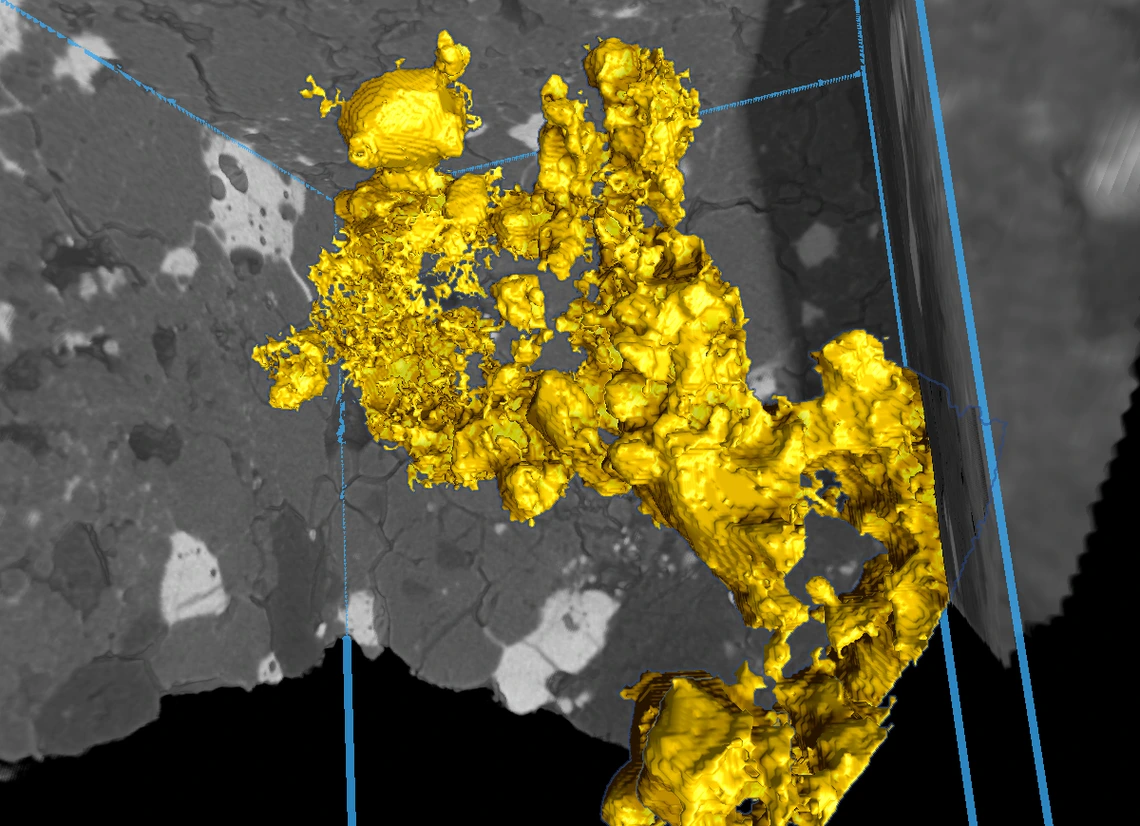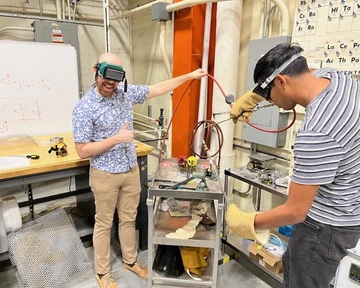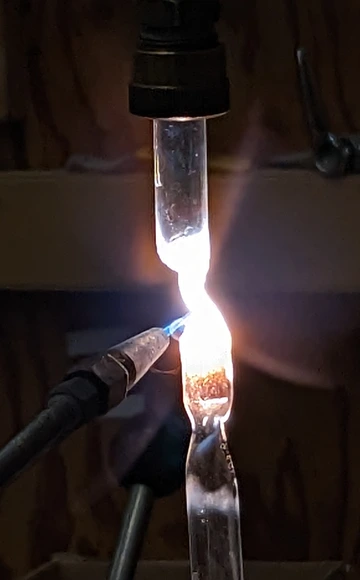Percolating clues: A new way to build planetary cores

A molten sulfide network (colored gold) percolates between silicate mineral grains in this cut-out of an XCT rendering—rendered are un-melted silicates in gray and sulfides in white. The boundaries of the blue box are 100 micrometers wide – slightly more than the average width of a human hair.
Crossley et al. 2025, Nature Communications
A new study led by Sam Crossley at the University of Arizona Lunar and Planetary Laboratory reveals a surprising new way planetary cores formed. The findings could reshape how scientists understand the early evolution of rocky planets like Mars.
Published in Nature Communications, the study offers the first direct experimental and geochemical evidence that molten sulfide, rather than metal, can percolate through solid rock and form a core, even before a planet's silicate mantle begins to melt.
The study was conducted by a team of early-career scientists and long-time researchers across the Astromaterials Research and Exploration Science, or ARES, Division at NASA's Johnson Space Center.

Trading lab coats for welding goggles, the research team set out to recreate planetary conditions in the lab. Here, Crossley and Anzures are seen working together to develop new experimental assembly designs and methodologies for melting experiments.
Amentum/Kayla Iacovino
Planets in the early solar system began their lives by coalescing from gas, dust and ice. As they grew, heat produced from the decay of radioactive elements caused minerals to begin melting, providing a pathway for a planet to segregate into the familiar layered structure of core, mantle and crust. For decades, scientists believed that forming a core required large-scale melting of a planetary body, followed by heavy metallic elements sinking to the center. This study introduces a new scenario, by which cores could have begun forming earlier and without the need for the young planet to undergo melting as a whole.
The results, according to the research team, are especially relevant for planets forming farther from the sun. There, in the solar system's outer reaches, abundant volatiles like sulfur and oxygen behave like road salt on an icy street – lowering the melting point of metals by reacting with iron metal to form iron-sulfide. This destabilizes the metals and allows them to migrate and combine into a core. The problem? Until now, scientists didn't know if sulfide could travel through solid rock under realistic planet formation conditions.

Sam Crossley welds shut the glass tube of the experimental assembly. To
prevent reaction with the atmosphere and precisely control oxygen and sulfur content,
experiments needed to be sealed in a closed system under vacuum.
Amentum/Brendan Anzures
"We could actually see in full 3D renderings how the sulfide melts were moving through the experimental sample, percolating in cracks between other minerals," Crossley said. "It confirmed our hypothesis – that in a planetary setting, these dense melts would migrate to the center of a body and form a core, even before the surrounding rock began to melt.”
Recreating planetary conditions in the lab required not only experimental precision but also close collaboration among early-career scientists across ARES to develop new ways of observing and analyzing the results. The team used chips of genuine meteorites as well as synthetic minerals doped with trace amounts of noble metals to observe how those elements behave during this melt percolation process.
As molten sulfide moved through solid rock at high temperatures in a lab experiment, Scott Eckley, an X-ray scientist at ARES, used X-ray computed tomography to produce high-resolution 3D renderings – revealing melt pockets and flow pathways within the samples in microscopic detail. These visualizations offered insight into the physical behavior of materials during early core formation without destroying the sample.
To understand the distribution of trace elements, study co-author Jake Setera developed a laser ablation technique to trace noble metals such as platinum, palladium and iridium, which are known to concentrate in iron metal found in planetary cores and meteorites. These elements tend to "prefer" metals and sulfides over silicate rock, making them ideal indicators of core formation processes.
"We searched for forensic evidence of sulfide percolation in meteorites," Crossley explained. "By partially melting synthetic sulfides doped with trace metals, we were able to reproduce the same anomalous chemistries we'd previously seen in oxidized meteorites. That was a strong indication that percolative sulfide core formation had actually occurred in the early solar system."
When paired with Setera's geochemical analysis, the geochemical data provided powerful, independent lines of evidence that molten sulfide had migrated and coalesced within a solid planetary interior – a process that, until now, had not been directly confirmed in a laboratory setting.
The study offers a new lens through which to interpret planetary geochemistry. Mars in particular, shows signs of early core formation – but the timeline has puzzled scientists for years. The new results suggest that Mars' core may have formed more efficiently, and therefore more rapidly and sooner, due to its sulfur-rich composition, potentially without needing to first undergo full-scale melting like Earth did.
The results also raise new questions about how scientists date core formation events using radiogenic isotopes, such as hafnium and tungsten. If sulfur and oxygen are more abundant during a planet's formation, certain elements may behave differently than expected – remaining in the mantle instead of the core and affecting the geochemical "clocks" used to estimate timelines of planet formation and evolution.
"This study advances our understanding of how planetary interiors can form under different chemical conditions – offering new possibilities for interpreting the evolution of rocky bodies like Mars," Crossley said.
As NASA prepares for future missions to the moon, Mars and beyond, understanding how planetary interiors form is more important than ever. Studies like this one help scientists interpret remote data from spacecraft, analyze returned samples and build better models of how our solar system came to be.
Crossley led the research during his time as a McKay Postdoctoral Fellow – a program that recognizes outstanding early-career scientists within five years of earning their doctorate. Jointly offered by NASA's ARES Division and the Lunar and Planetary Institute, the fellowship supports innovative research in astromaterials science.





